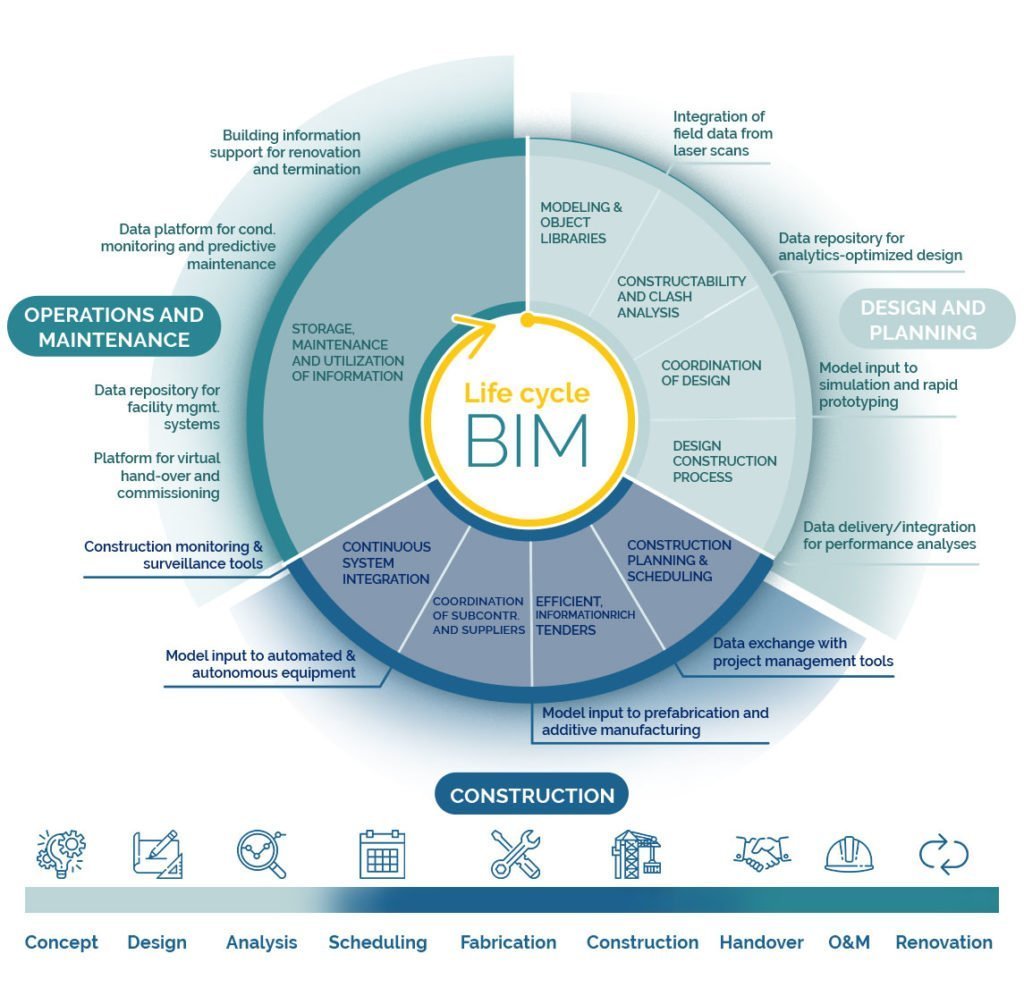A huge amount of data is generated at every single stage of a project’s lifecycle, and this is where Building Information Modeling (BIM) comes into play. Do you know what this innovative trend is all about?
BIM is not just a type of software, but a methodology. Building Information Modeling refers to a highly collaborative real-time process for the generation and intelligent management of a building’s data that is gathered during its entire life cycle.
Continue reading to learn more about the benefits of BIM in the built environment and how it helps enhance the different stages throughout the construction process.
What does BIM stand for?
BIM stands for Building Information Modeling. The main added value of BIM is the way in which it groups information from all of the stakeholders involved, including data such as: geometry, environment, geography, materials, spatial relationships, costs, etc.
This methodology makes building and infrastructure planning, design, construction, and management much more efficient and it has become a central concept in the digital transformation of the construction industry, as well as making a real impact in terms of sustainability.

Although it was first introduced to the market in 1992, BIM started gaining traction a little over 10 years later. Nowadays, besides being a catchy acronym for those committed to innovation in the construction industry, it has become an essential part of the sector.
With some governments enforcing the use of BIM in new projects and a growing understanding of its benefits to the AEC industry, the BIM global market is expected to grow from the 4.5 billion USD reported in 2020, to 21.15 billion USD by 2032, with North America spearheading its use, followed by Europe and Asia Pacific.
How does BIM work?
Building Information Modeling integrates smart insights to tangible aspects of a building. Not to be confused with Computer Aided Designs (or CAD), whose purpose is focused solely on drafting and design, BIM uses CAD as a tool for bringing broad-scoped information about a building together.
Simply put, BIM makes CAD drawings come alive; it makes them become smarter, more dynamic, and provides much more information of the many systems that can be integrated into a building. When implemented effectively, it can also influence changes in the CAD.
Moreover, it also helps to digitize many aspects of the building’s lifecycle, going further beyond only the design phase. In times when smart buildings are also becoming all the rage, it’s crucial that facility managers also become smarter in their ways of handling them.
Can you guess what can help them? Yes, BIM! This methodology can provide a complete context for buildings and the systems that regulate them, making the “I” in BIM the epitome of information-driven decision-making.
Keep reading to learn more about how it can be used in the different phases of a construction project.

The phases of BIM explained
Like any well-defined venture or project, there are phases that must be completed in a particular order and with BIM there is no exception. BIM can be employed in the following phases of a project:
- Pre-design/Planning: Also known as the preconception phase, this first stage is crucial, since many plans and long-term decisions for the construction project will be considered.
- Design: At this point, you will be using BIM software to make 4D and even 5D smart comprehensive, accurate, and flexible estimations.
- Construction: With estimating and scheduling out of the way, BIM keeps the construction process on track and ensures congruence between design and physical structure.
- Operations and Maintenance: Once a building is up and running, BIM helps prevent and correct different maintenance issues and manage building assets.
The main advantages of BIM
BIM is becoming increasingly prominent in construction projects given that it allows for the optimization of both the time and resources allocated for these tasks. However, implementing this methodology does not come without new challenges.
To be able to fully make use of the extensive range of improvements that this system offers, we must invest in the equipment and resources necessary to sustain it. Luckily, with the expected adoption of BIM technologies growing exponentially around the world, the benefits will become increasingly clear to the few non-believers who might still be out there.
Amongst its many benefits, some advantages of Building Information Modeling are:
Sustainability
Sustainability, a key and growing component of the design process of a structure, can be easily addressed by BIM. For instance, engineers can perform a better environmental analysis, exploring aspects like a building’s orientation, energy consumption and access to daylight to help identify the best strategies that enhance its energy efficiency, waste management and water conservation.
Perhaps less crucial but equally important, thanks to the use of digital platforms and cloud computing, BIM can also help reduce paper usage and waste during the design and construction phases.
Increased efficiency
Using BIM allows construction projects to run shorter lifecycles with greater efficiency, as all aspects of the pre-construction and planning phases become easier to manage and faster to complete.
For example, architects can create designs faster with BIM software and project managers can produce more accurate estimations of its costs through BIM models.
Enhanced communication and collaboration
BIM facilitates the integration of different people involved in the project, allowing to reduce fragmentation and miscommunication in the processes.
Since everything can be digitized using BIM-related software, all stakeholders can access plans and other related documents whenever they need to (plus ensuring they do so on an updated and federated model). This helps to reduce errors and rework that come from using incorrect or inaccurate information.
Jobsite safety
The workers’ safety has always been a priority for both Cemex and the industry. Nowadays, BIM helps identify hazards and potential damage much easier and in a faster way than traditional methods.
Also, considering other factors like a potential spread of COVID-19 on site during the pandemic, BIM can offer virtual walkthroughs of a project allowing management to continue work without exposing workers unnecessarily.

Other advantages
As stated earlier, this innovative methodology offers countless advantages and uses and is rapidly gaining more ground in the construction sector. Likewise, it is anticipated that more technologies will be incorporated into its capabilities, which will soon allow for the complete digitalization of the construction value chain.
We are very interested in the further development of areas such as virtual reality, offsite construction and 3D printing which can enable clients to discover exactly how an installation will turn out, as well as automate the creation of mock-ups and overall foster innovation within the industry.
And who is leading the BIM efforts in the industry? According to a recent report from the Market Research Future, North America, Europe and Asia Pacific are quickly becoming the first adopters of BIM.
North America is leading in the investment and adoption of BIM technologies. The presence of top industry players, increasing investments to develop advanced infrastructure facilities, and increased adoption of cloud-based engineering are adding to BIM software market growth in the region.
In Europe, the BIM software market is predicted to have the second-largest share up until 2026. The growing construction sector, government and private entity regulations, and high demand for BIM software by building owners, architects, and contractors is helping fuel BIM software market growth.
Not to be missed, the Asia-Pacific region is predicted to grow its BIM market at a very fast pace. The region’s focus on digitalization, prosperous real estate market, growing adoption of cloud platforms, high growth rate, and increasing adoption of advanced technologies to enhance the competitive edge of the design and construction industry in China are contributing to BIM software market growth.

How does BIM optimize each phase of the construction process?
The construction process isn’t just building something. When you start hearing the noise of trucks arriving on-site and seeing workers beating under the midday sun, you begin to understand the extensive work that goes into the construction process. Regardless of size and complexity, going from an idea to a reality is a long and complicated process.
BIM can help to optimize the different stages of the process and make it much more efficient and easier to handle for everyone involved. From streamlining the design and planning process to organizing multiple contractors, managing expensive and dangerous equipment, and working on a large building site, let’s take a look at how this innovative methodology can be implemented in different ways throughout a project’s lifecycle and benefit the different phases of the construction process.
Planning and design
The planning and design phases of a construction project can best be viewed as an integrated system. With BIM, a very useful tool for simulation, prototyping and analyzing during these stages, the inclusion of data works as a repository for the optimized design and performance analytics.
With BIM considerable savings can be made, not only in terms of time but also in terms of resources. Many times, unforeseen situations or incompatibilities can occur during a construction process –for instance, a pipe colliding with another element or non-compliance with regulations– and these are situations that traditionally would have to be resolved on site.
However, through BIM we are now able to avoid these issues thanks to the fundamental role that BIM plays in the planning procedures, and thanks to the early detection of potential problems in any of the different parts that make up a project.
Construction
BIM enables many stakeholders and people involved in a project’s construction to come together. It facilitates stakeholder collaboration and the exchange of information different project teams through smart tools, but it also permits real-time monitoring of the construction work done on site and the coordination with suppliers and others in the supply chain. The result is a more streamlined and efficient construction phase.
Moreover, BIM enables the state of construction to be visualized, meaning that it is possible to compare at any given time the current structure with its expected evolution produced during the design phase. This offers optimum control of the deliveries of the different elements of a project and makes it possible for possible obstructions to be detected.

Operations and maintenance
The last leg of a functional building’s lifecycle is essentially one of the most important ones. Once a building is in use BIM technologies can help make operation smoother and more seamless.
The BIM methodology goes far beyond just construction work. Once an infrastructure has been built, it can be used to help provide the client and facility managers with the correct tools to operate MEP and HVAC, plus deal with maintenance issues via a digital twin: installation date, materials, lifespan, etc.
Take a look at our previous blog entry regarding smart buildings to read a further explanation of how BIM plays a crucial role in the implementation of sensors and smart technologies that guarantee that operations and maintenance of assets are done in the most efficient and innovative way.
Cemex Ventures and Building Information Modeling in the construction industry
BIM takes construction digital and digital tools are no longer a plus for construction companies, but a necessary component to keep up with increasing project complexities.
To lead the construction industry revolution Cemex Ventures is looking to partner with, accelerate, and invest in startups who fall under our “Enhanced Productivity” investment pillar, such as DroneDeploy, formerly known as StructionSite, and Outbuild, formerly known as ProPlanner and IPSUM.
DroneDeploy
DroneDeploy, formerly known as StructionSite, offers a software solution that maximizes all the benefits that BIM has to offer. They offer a platform that creates digital worksite models through 360º cameras that provide data to its software, which digitalizes and documents worksite progress.
Through the user’s position, ‘Computer Vision,’ and ‘Machine Learning’ technology, DroneDeploy’s software processes, analyzes, and creates images of the worksite to identify key elements and evaluate advancements.
Their software streamlines the construction project phase by reducing the time to calculate progress and obtaining contextualized information in order to enable strategic decision-making and improve coordination between all actors involved.
Outbuild
Outbuild, formerly known as IPSUM and then ProPlanner, is a Chilean startup that developed a SaaS for scheduling and planning construction projects based on lean construction and BIM.
Their web-based and collaborative platform is used for building robust construction schedules and allows trade partners to create their weekly and daily activities, manage resources, and improve coordination between stakeholders through every stage of a construction project. These past winners of Construction Startup Competition 2017 have expanded from South America to North America with their easy-to-use system.
The future of the construction industry will be many things. Undoubtedly, one of which will be digital.
Does your startup have a solution related to BIM or digitalization that can revolutionize the construction industry?
Grow your network, earn capital and exposure to investors, and partner with a household name in the industry. Contact us today and a member of our investment team will be in touch with you.

